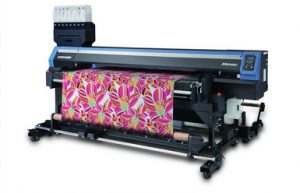- Wed
- 19
- Oct
- 2016
Mimaki to launch new belt-driven Textile Printer
The 1.8m-wide Tx300P-1800B, a belt-driven version of the Tx300P-1800, has been developed to complement the larger textile machines from La Meccanica Costruzione Tessili, which Mimaki acquired earlier this year. It will be commercially available in the first two months of 2017.The machine is suitable for printing fabrics including bulky textured materials as well as sheer fabric and stretchy materials such as knits. The potential for crumpling and bending of fabrics during the print process is reduced by the belt conveyance system, which incorporates a “crumple-free roller” and “paste roller” to ensure stable print results.The device can print at speeds of up to 50sqm/hr, with high quality achievable at up to around 22sqm/hr, and can achieve print resolutions of up to 1,440dpi.It is also said to eliminate the need for steaming or washing when printing with Mimaki TP400 textile pigment inks, reducing time, cost and potential water pollution.Mimaki EMEA general marketing manager Mike Horsten toldPrintWeek the belt media transport system will enable the printer to be used for a wide range of applications.“It would have been impossible before to print any elastic fabrics or anything that would not be considered stiff. With the belt system we can do all kinds of flexible materials such as thin materials, silks and materials where you need to penetrate.
“It also opens Mimaki’s printing capabilities into reactive, acid and disperse areas where you really need a belt. The biggest positive is that it also opens up the market for sampling.”
Mimaki will offer five different ink types with the machine including Sb420 Sublimation Dye Ink, which is designed to work perfectly with polyester-based textiles, Dd400 Dispersion Dye Ink, which is said to deliver high light-fastness and build-up on polyester and micro-polyester, and TP400 Textile Pigment Ink, which can print on textiles including polyester, cotton, silk, viscose, rayon and wool.
Also available will be Rc400 Reactive Dye Ink, which is suitable for printing on natural fibres such as cotton, silk and wool, and Ac400 Acid Dye Ink, both of which require pre-treatment and post-treatment of the fabrics to prevent fading and bleeding of colour.
These inks are are said to produce bright, deep colours in the complete gamut of shades required by the fashion and apparel industry as well as good light- and water-fastness.
The machine’s waveform control function allows each ink to be jetted according to its own specific gravity and viscosity, which enables precise placement of ink droplets onto the fabric.
Pricing for the Tx300P-1800B has not yet been determined but Horsten said it would be in line with other belt-driven systems that deliver high-quality print at speeds of around 20sqm/hr. Due to the belt it will cost more than the original Tx300P-1800 model, which will remain available.


